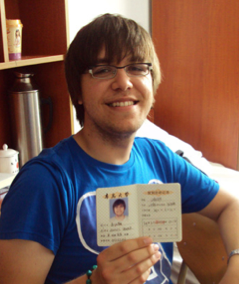Passionate Language Learners Pursue Their Individual Visions for "Skills for a Shrinking Planet"
By Lisa Raleigh

Dennis Tanner, who grew up in a household where both Spanish and English were spoken, is an advanced student of Chinese. But he is now exploring his heritage and also studying Spanish.
UO junior Dennis Tanner is a one-man multilingual phenomenon, on the path to mastery of the world’s three most prominent languages: English, Chinese and Spanish.
Spanish is a family language for Dennis; he was born in Southern California to a Mexican mother and an American father. But while his mother and grandmother spoke Spanish in the home, they did not teach it to him. He grew up speaking English only, like his dad.
When it came time to study a language in high school, the obvious choice might have been Spanish. But Dennis pursued a completely unexpected direction, choosing instead to enroll in Chinese—inspired, in part, because his father worked for a Japanese car company and this had sparked his interest in Asian culture.
Chinese turned out to be much more than a casual exploration, however: Dennis has been so thoroughly dedicated to learning the language—and has demonstrated such an exceptional talent for it—that he is now part of a selective National Security Education Program at the UO that is preparing him to achieve the highest possible skills in Chinese.
Yet he is also now exploring his heritage and studying Spanish at the UO. In fact, when he begins a year abroad at Nanjing University in China this fall, he will continue studying Spanish there.
Yes, studying Spanish in China.
The Language Triumvirate
It’s well known that English and Mandarin Chinese dominate the world’s linguistic scene, with more than a billion speakers each. These numbers increase every day because people around the world are seeking to improve their personal or commercial currency in a globalized world. English remains the lingua franca for a huge range of global exchanges, and Chinese is not far behind.
Consider this seemingly small fact: Tour guides in the western regions of Costa Rica are being encouraged to learn Mandarin, in large part because a new fisheries agreement between Costa Rica and China is prompting an unprecedented influx of Chinese tourists. Multiply this by the long list of countries, large and small, where China is having an economic impact and the linguistic implications become clear.
China’s market power touches all modern economies, even regional ones like the Pacific Northwest. Oregon, for instance, exported more than $4 billion in goods to China in 2010—a 1,277 percent increase in the last decade—making China the state’s largest export market for the second consecutive year. Clearly China is a force to be reckoned with and the language beckons those who wish to be at the top of their game internationally.
Less known perhaps is the standing of Spanish as the world’s third largest language, with half a billion speakers worldwide. By some accounts, the number of native Spanish speakers equals—or even exceeds—the number of native English speakers (approximately 400 million each). It is the third most commonly used language on the Internet, after English and Chinese.
On the Ascendancy
Like English and Chinese, Spanish is also on the ascendancy, but for very different reasons. It is primarily a hemispheric phenomenon, with the Western Hemisphere home to twenty-one of the twenty-two countries where Spanish is an official language (the twenty-second is Spain).
While Spanish has no official status in the U.S., the United States is home to the second largest Spanish-speaking population in the world, with 50 million speakers (35.5 million of them native speakers). Only Mexico tops the U.S., with 109 million total.
As the Hispanic population in the U.S. continues to grow—the U.S. Census projects it will increase to 132.8 million by 2050—so will the ranks of native speakers. At the same time, English- speaking students will continue to drive the Spanish-as-a-second-language trend.
“English speakers increasingly see Spanish as part of their own culture,” said Leonardo García-Pabón, a UO Spanish professor.
Moreover, relationships between the U.S. and Latin America are becoming increasingly complex, sophisticated and interdependent, creating increased demand for Spanish-language speakers who are savvy about the finer points of Hispanic cultures and communication.
Common Ground
The UO is committed to fostering “skills for a shrinking planet.” For students wishing to master a language, the ultimate goal is a “superior level of proficiency”—meaning a full suite of communication skills that go far beyond the conversational. Proficient speakers are able to dialog in-depth on their area of expertise (business, academic, scientific and so forth) with colleagues, peers and superiors, and also express themselves at the highest professional level in writing.
Fostering proficiency for Spanish and Chinese instruction takes different forms at the UO, as the following stories will show. Spanish is a “big tent” that allows students to pursue an eclectic range of options while Chinese instruction tends to be much more precision focused—as exemplified by the UO Chinese Flagship Program, which expects students to not only master Chinese but also earn a degree in a separate subject area.
But the common ground between the two (besides the rare student like Dennis Tanner who embodies both) is the wealth of possibilities they offer for passionate language learners.




 Watch
Watch  Watch excerpts from the opera, coming soon to Eugene.
Watch excerpts from the opera, coming soon to Eugene. 

 Three’s a charm for a living memorial.
Three’s a charm for a living memorial.